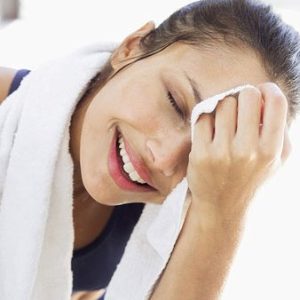
By: Darrell W. Butler
TFW/Parisi Sports Performance Coach; ACE, NFPT CPT
—
99F… 37C… 102F… Oh no, I’m not playing Battleship, I’m just reading off some of the temperatures from around the world this crazy Summer. As tempting as it may be to spend your time sipping on a Slurpee with a fan blowing directly up your shorts; there’s still work to be done my friend!
Summer doesn’t end officially until late September, so we’re not out of the heat yet, and there is no excuse to slack off on your workouts in the meantime. You’ll still have to be strategic in your approach to beating the heat, so here are some key recommendations for a successful outdoor workout as you enjoy the transition from Summer to Fall.
1. Adjust your workout times
If your schedule is flexible, it might be wise to workout earlier in the morning or later in the evening when the temperature isn’t as high and the humidity is most likely lower. The sun tends to be most dangerous between noon and 2:00pm, so instead of taking that lunchtime walk outside, maybe try hitting the stairs or if there’s a mall nearby, walk around there, just try not to get too distracted and end up at Cinnabon!
2. Dress appropriately
Light colors are highly recommended as they won’t attract the sun’s heat quite as much as darker options. Natural, loose-fitting fabrics also work best, so if you have a white cotton tee; that should be your first option!
Some fitness companies also offer specialty workout clothes that provide heat protection. You can typically find the sun protection levels indicated on the label. Whichever option you choose, the fabric should be breathable and comfortable as not to cause chaffing or excessive sweat buildup.
Complete your look with a hat and dark wraparound sunglasses to help protect your eyes and prevent headaches.
3. Don’t forget the sunscreen!
No matter the duration of your workout, and no matter how much of a breeze there is, you’ll want to cover your exposed skin with a layer of sunscreen. The particular SPF level can be determined by your sensitivity to the sun but typically the higher the better. Look for a sunscreen made for sport activities and sweat, however to ensure that it will feel comfortable and remain effective throughout the duration of your workout.
Aside from preventing sunburn and decreasing the risk of cancer, sunscreen also helps prevent wrinkles, so this should be a no-brainer to include in your summer pre-workout routine!
4. Stay hydrated
This is more than merely a fitness cliché – proper hydration levels are even more essential when it’s hot outside since you’re likely to sweat more than usual. Water will not only help to keep you cooler, but will also help prevent cramps, dizziness and heart palpitations, while simultaneously keeping your metabolism humming.
Please note that I specifically said water. Sports drinks and other sugary beverages combined with the heat may actually have an adverse affect on your stomach and your blood sugar levels. Unless you’re an endurance athlete working out for an extreme amount of time, water is always the best option.
Although it goes without saying that both options are better than a Presidente Margarita, so choose your beverages wisely!
5. Still eat… and not just ice cream!
Sure, the heat may cause you to lose your appetite, but it’s still vital that you get a proper balance of nutrients into your system; especially if you’re going to place heavy demands on your body by working out in the sun.
If you frowned throughout the entire section on water, you’ll find comfort in the fact that you can also fulfill some of your bodies hydration needs through water based vegetables such as lettuce, cucumbers, tomatoes and more. Please note that I only said “some”, so I’m not suggesting that you run around the neighborhood carrying a cooler full of veggies! You’ll still just have to suck it up and drink the H2O buddy!
It’s especially important that you eat a high quality meal that’s balanced with protein, carbohydrates and essential fats after your workout to replenish the nutrients and fluids lost during your routine.
6. Take extra breaks
You’ll have to remember that you may not be able to perform as efficiently in extreme temperatures as you could under normal circumstances. Forgive yourself and allow yourself to take breaks.
There’s a fine line between “pushing through the pain” and “pushing too far.” To help learn the difference, keep an exercise and food journal, particularly on workout days. Perhaps your sluggish feeling is the result of ignoring one of the several tips listed above? Perhaps it’s due to even higher temperatures that day or your body struggling to adapt to your new routine.
Whatever the reason, it’s best to listen to your body in the moment, allow time to rest and adapt and then further analyze the situation at a later time.
7. Remember that your flexibility may not be the same indoors
How cool is it that after your workout in the sun, you can suddenly stretch yourself info a pretzel like Gumby? Amazing right? If you’ve ever taken a Bikram or Hot Yoga class you’ve probably also noticed a similar effect. That’s because the human body is much more flexible in heat as the blood flows easier and the muscles are able to expand and relax.
It’s a great feeling to pull off a split when you used to not be able to touch your toes, but keep in mind that your superpowers won’t be the same once you return indoors. Remember those old Ball Park Franks commercials where “they plump when you cook ’em”? Or even better, have you ever put one of those Easter Peeps in the microwave? They got huge right?! But once you took them out of the heat, they shriveled back down.
The same can be said for your flexibility, so enjoy the added mobility, and use it to work on becoming more flexible since you will maintain some of the gains. Just know that you may have a harder time replicating this feat in the winter!
